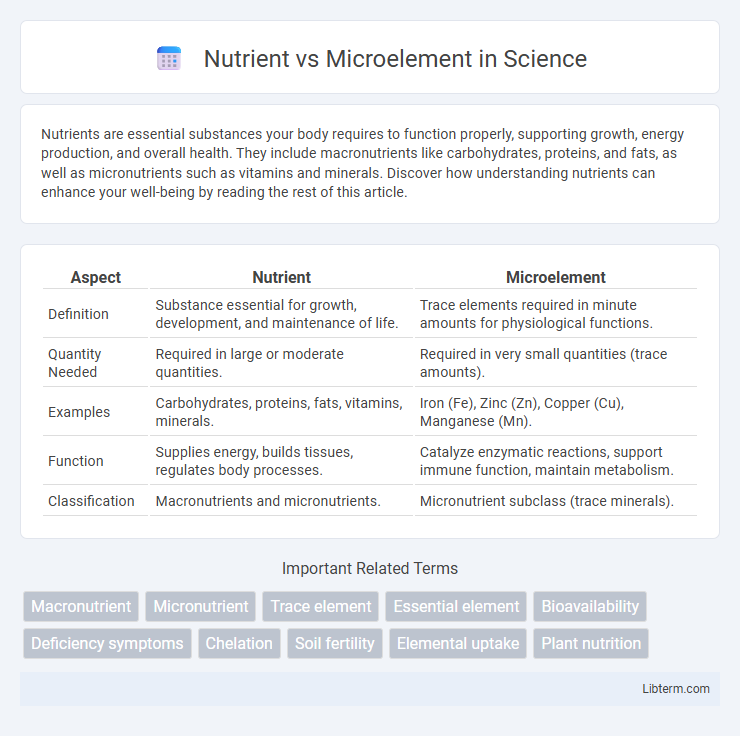Nutrients are essential substances your body requires to function properly, supporting growth, energy production, and overall health. They include macronutrients like carbohydrates, proteins, and fats, as well as micronutrients such as vitamins and minerals. Discover how understanding nutrients can enhance your well-being by reading the rest of this article.
Table of Comparison
| Aspect | Nutrient | Microelement |
|---|---|---|
| Definition | Substance essential for growth, development, and maintenance of life. | Trace elements required in minute amounts for physiological functions. |
| Quantity Needed | Required in large or moderate quantities. | Required in very small quantities (trace amounts). |
| Examples | Carbohydrates, proteins, fats, vitamins, minerals. | Iron (Fe), Zinc (Zn), Copper (Cu), Manganese (Mn). |
| Function | Supplies energy, builds tissues, regulates body processes. | Catalyze enzymatic reactions, support immune function, maintain metabolism. |
| Classification | Macronutrients and micronutrients. | Micronutrient subclass (trace minerals). |
Understanding Nutrients and Microelements
Nutrients are essential substances required by organisms for growth, energy, and maintenance, encompassing macronutrients like carbohydrates, proteins, and fats. Microelements, or trace elements, are vital nutrients needed in minute amounts, such as iron, zinc, and copper, crucial for enzymatic functions and metabolic processes. Understanding the distinction between nutrients and microelements highlights their different roles in biological systems, where macronutrients provide bulk energy and structural components, while microelements facilitate specific biochemical reactions.
Defining Nutrients: Macro vs Micro
Nutrients are essential substances required by organisms for growth, development, and metabolic functions, classified into macronutrients and micronutrients. Macronutrients, including carbohydrates, proteins, and fats, are needed in larger quantities and provide energy and structural components. Micronutrients, such as vitamins and microelements like iron, zinc, and copper, are required in smaller amounts but are crucial for enzymatic activities, immune function, and overall cellular health.
What Are Microelements?
Microelements, also known as trace elements, are essential nutrients required by organisms in minute quantities to maintain vital physiological functions. These include iron, zinc, copper, manganese, and iodine, which play critical roles in enzymatic activities, hormone production, and cellular metabolism. Unlike macronutrients, microelements are needed in smaller amounts but are indispensable for growth, development, and overall health.
Key Differences Between Nutrients and Microelements
Nutrients are essential chemical elements required by organisms for growth and metabolism, classified into macronutrients such as nitrogen, phosphorus, and potassium, which are needed in large quantities, and micronutrients, also known as microelements, including iron, manganese, zinc, and copper, required in trace amounts. Microelements play specific roles in enzymatic functions and physiological processes despite their small concentrations, while macronutrients provide structural and energy components fundamental to cellular function. The key difference lies in the quantity needed and functional specificity: nutrients encompass both large-scale and trace elements, whereas microelements specifically refer to essential trace nutrients critical for biochemical activities.
Roles of Nutrients in Human Health
Nutrients, including macronutrients like carbohydrates, proteins, and fats, provide the essential energy and building blocks necessary for growth, repair, and overall bodily function. Microelements, such as iron, zinc, and selenium, serve crucial roles as cofactors in enzymatic reactions, immune system support, and antioxidant protection. The synergy between macronutrients and microelements ensures optimal metabolic health, cognitive function, and cellular homeostasis in the human body.
Importance of Microelements in the Body
Microelements, also known as trace elements, are vital for numerous physiological functions despite being required in minute amounts compared to macronutrients. Essential microelements such as iron, zinc, copper, and selenium play critical roles in enzyme function, immune response, and antioxidant defense mechanisms. Deficiencies in these microelements can lead to significant health issues, including impaired cognitive development, weakened immunity, and metabolic disorders.
Common Sources of Nutrients and Microelements
Nutrients essential for plant growth include macronutrients such as nitrogen, phosphorus, and potassium, commonly found in organic matter, fertilizers, and compost. Microelements or trace elements like iron, manganese, zinc, copper, and boron are typically sourced from soil minerals, foliar sprays, and micronutrient-enriched fertilizers. Both nutrients and microelements play crucial roles in plant metabolism, influencing overall health and crop yield.
Signs of Deficiency in Nutrients and Microelements
Signs of deficiency in nutrients often include stunted growth, chlorosis, and poor yield, indicating essential macroelements like nitrogen, phosphorus, and potassium are lacking. Microelement deficiencies, such as iron, zinc, or manganese, typically manifest as interveinal chlorosis, necrotic spots, and distorted leaf shape. Early detection of these symptoms is crucial for targeted fertilization and maintaining optimal plant health.
Daily Requirements and Recommended Intakes
Nutrients are essential substances required in larger daily amounts, such as carbohydrates, proteins, fats, vitamins, and minerals, which collectively support overall health and metabolic functions. Microelements, or trace elements, are minerals needed in minute quantities, typically less than 100 mg per day, including iron, zinc, copper, selenium, and iodine, critical for enzymatic reactions and physiological regulation. Recommended daily intakes vary by age, sex, and physiological status, with macronutrients measured in grams and microelements in micrograms or milligrams, reflecting their distinct roles and quantities necessary for maintaining optimal health.
Optimizing Nutrition: Balancing Nutrients and Microelements
Optimizing nutrition requires a precise balance between macronutrients--such as carbohydrates, proteins, and fats--and microelements including vitamins and trace minerals like iron, zinc, and selenium. Adequate intake of microelements ensures enzymatic functions, immune support, and cellular metabolism, complementing the energy and structural roles of primary nutrients. Strategic dietary planning that harmonizes nutrient and microelement levels enhances overall health, metabolic efficiency, and disease prevention.
Nutrient Infographic

 libterm.com
libterm.com